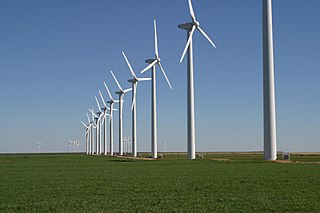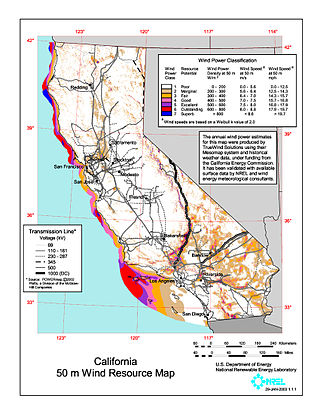Bluewater Wind is an energy company on the North Atlantic Coast, United States, and in the Great Lakes Region, United States, developing offshore wind energy projects. Bluewater's staff has experience in the wind, energy, environmental, finance, public policy, and marine sectors. Bluewater Wind was part of the Babcock & Brown family of companies. [1] and become part of NRG Energy.
In response to public requests, Bluewater selects offshore locations, conducts environmental studies and assesses wind resources. In addition, Bluewater selects contractors who plan connection to the grid and arrange for delivery of the energy to customers. Lastly, Bluewater secures financing early on in the development process to see the project through from concept to decommissioning.
Every new project begins with information transparency early on in project development, discourse with local stakeholders and voluntary project modifications in response to public input. The company engages with local environmental, trade, union, community, and academic organizations in order to assess the needs and wants of the community.
For example, the companies level of public engagement led to the scrutiny of one potential project site located in the Delaware Bay during the summer of 2007. Local bird protection organizations were concerned about the impact that the wind turbines would have on the migratory pattern of the birds that fly over the bay. The organizations provided evidence of their concerns and explained to Bluewater project management the real costs involved with the site. As a result, the company ceased developments for that site.
Bluewater Wind is an offshore wind energy developer, with the only offshore wind energy power purchase agreements (PPAs) in the U.S. and two permits to install meteorological towers on the outer continental shelf for the company's North Atlantic Coast projects. As such, Bluewater is executing projects in Delaware, New York, New Jersey, Rhode Island and has begun expanding project development opportunities into the Great Lakes.
The Delaware Offshore Wind Farm was a proposed offshore wind farm project, to be situated off the Delaware coast Delmarva Power of Delaware agreed to purchase 200 megawatts of power from a large wind farm to be operated by Bluewater Wind offshore from Rehoboth Beach, Delaware. [2] Originally planned[ when? ] to be 600 MW, the Delaware project is expected to be built as 200 MW initially[ when? ], and is frequently referred to as the Bluewater Wind Park, although Bluewater Wind is also planning wind parks in four other states, New York, New Jersey, Maryland, and Rhode Island.[ citation needed ] Environmental information, including environmental impact statements, for the Delaware Offshore Wind Farm are published by the Aeorads Company, an information technology company. [3] [4] [5] The Delaware project was located in the same area as the Atlantic Wind Connection [6] proposed by Google and others.
Bluewater Wind handled port logistics for Coastal Virginia Offshore Wind. [7]

Wind power is a branch of the energy industry that has expanded quickly in the United States over the last several years. From January through December 2022, 434.8 terawatt-hours were generated by wind power, or 10.25% of electricity in the United States. The average wind turbine generates enough electricity in 46 minutes to power the average American home for one month. In 2019, wind power surpassed hydroelectric power as the largest renewable energy source in the U.S.

Wind power in California had initiative and early development during Governor Jerry Brown's first two terms in the late 1970s and early 1980s. The state's wind power capacity has grown by nearly 350% since 2001, when it was less than 1,700 MW. In 2016, wind energy supplied about 6.9% of California's total electricity needs, or enough to power more than 1.3 million households. Most of California's wind generation is found in the Tehachapi area of Kern County, California, with some large projects in Solano, Contra Costa and Riverside counties as well. California is among the states with the largest amount of installed wind power capacity. In recent years, California has lagged behind other states when it comes to the installation of wind power. It was ranked 4th overall for wind power electrical generation at the end of 2016 behind Texas, Iowa, and Oklahoma. As of 2019, California had 5,973 megawatts (MW) of wind power generating capacity installed.

Wind power is the fastest-growing renewable energy technology in Scotland, with 11,482 megawatts (MW) of installed wind power capacity by Q1 2023. This included 9,316 MW from onshore wind in Scotland and 2,166 MW of offshore wind generators.
New York has 2,192 MW of installed wind power capacity as of 2022. Most of New York's wind power is located in upstate New York as onshore wind farms. New York has set a goal of developing 9,000 MW of offshore installed wind power capacity by 2035 that will power an estimated 6 million homes. As of October 2022, New York has five offshore wind farms in development with approximately 4,300 MW installed capacity.
Ørsted U.S. Offshore Wind is an offshore wind energy development group that is affiliated with Ørsted, a Danish firm. It is joint headquartered in Boston, Massachusetts and Providence, Rhode Island. As of 2019, it was involved in some of the largest offshore wind farm projects in the United States.

Offshore wind power or offshore wind energy is the generation of electricity through wind farms in bodies of water, usually at sea. There are higher wind speeds offshore than on land, so offshore farms generate more electricity per amount of capacity installed. Offshore wind farms are also less controversial than those on land, as they have less impact on people and the landscape.

EDF Renewables is a wholly owned subsidiary of the French utility EDF Group, specializing in renewable energy production. As an integrated operator, the Group develops and finances the construction of renewable energy facilities, and manages operations and maintenance for its own account and for third parties.

The U.S. state of Massachusetts has vast wind energy resources offshore, as well as significant resources onshore. The 2016 update to the states's Clean Energy and Climate Plan had a goal of reducing 1990 baseline greenhouse gas emissions levels by 25% by 2020. Current goals include installing 3,500 megawatts (MW) of offshore wind power in the state by 2035. However, as of Q4 2021 the state had only 120 MW of wind powered electricity generating capacity, responsible for generating 0.9% of in-state electricity production. The state has awarded contracts to two offshore projects, the 800 MW Vineyard Wind project and 804 MW Mayflower Wind project. Construction began on the Vineyard Wind 1 project on November 18, 2021, after a long fight for approval. Commonwealth Wind was selected for development in 2021, but the developer has attempted to cancel the project due to increased costs. There are eight projects planned for off the southern coast of Massachusetts, though some will deliver power to Rhode Island, Connecticut, and New York.
Wind power in New Jersey is in the early stages of development. New Jersey has just six wind turbines, but the state has plans to develop several major offshore wind projects on the continental shelf of the Atlantic Ocean off the southern Jersey Shore. Legislation has been enacted to support the industry through economic incentives and to permit wind turbines on existing piers.
The following outline is provided as an overview of and topical guide to wind energy:

Wind power in Rhode Island is in the early stages of development. There are several small scale wind turbine projects in the state. As of December 2013 there were 11 turbines at 10 sites in the state. In 2014, Rhode Island had 9 MW of installed wind power capacity, which quickly rose to 75 MW in 2019.

Wind power in Virginia is in the early stages of development. In March 2015, Virginia became the first state in the United States to receive a wind energy research lease to build and operate offshore wind turbines in federal waters. Virginia has no utility scale wind farms.

Wind power in Maryland, which has land-based and offshore resources, is in the early stages of development. As of 2016, Maryland has 191 megawatts (MW) of wind powered electricity generating capacity, responsible for 1.4% of in-state generated electricity. Two offshore wind farm projects that will supply wind-generated power to the state are underway.

Wind power is a major industry in Taiwan. Taiwan has abundant wind resources however a lack of space on land means that most major developments are offshore. As of February 2020, there were 361 installed onshore turbines and 22 offshore turbines in operation with the total installed capacity of 845.2 MW.
Ocean Wind is a proposed utility-scale 2,248 MW offshore wind farm to be located on the Outer Continental Shelf approximately 15 miles (24 km) off the coast of Atlantic City, New Jersey. It is being developed by Ørsted US Offshore Wind in conjunction with Public Service Enterprise Group (PSE&G). Construction ) and commissioning are planned for the mid-2020s. The closed Oyster Creek Nuclear Generating Station and B.L. England Generating Station would provide transmission points for energy generated by the wind farm. It will be the largest producer of wind power in New Jersey and largest offshore wind farm in the United States.
Skipjack is a 966 MW capacity off shore wind farm, proposed by Ørsted US Offshore Wind to be built on the Outer Continental Shelf Offshore Delaware, approximately 16.9 nautical miles from the coast opposite Fenwick Island. It was originally projected that the project, which will provide power to Maryland, would be commissioned in 2022, It is one of the wind farm projects providing wind power to Maryland, the others being MarWin and Momentum Wind.
South Fork Wind Farm is a utility-scale offshore wind farm project on the Outer Continental Shelf Offshore Rhode Island (RI) which will provide energy to New York state.

The Coastal Virginia Offshore Wind (CVOW) is an offshore wind energy project located about 43 km (27 mi) off the coast of Virginia Beach, Virginia, U.S. The initial phase, a two-turbine, 12-MW pilot project constructed in 2020, is the second utility scale offshore wind farm operating in the United States. Dominion Energy and Ørsted US Offshore Wind collaborated on the project, which is estimated to have cost $300 million and is expected to generate enough electricity to power up to 3,000 homes. It is the first utility scale wind farm serving Virginia and the first built in U.S. federal waters, in a wind lease area that covers about 2,135 acres.

Offshore wind power is in the early stages of development in the United States. In 2016, the United States Department of Energy estimated that the country has a gross resource potential of 10,800GW of offshore wind capacity, with a "technical" resource potential of 2,058GW. Offshore wind projects are under development in wind-rich areas of the East Coast, Great Lakes, and Pacific coast. The first commercial offshore wind farm, Block Island Wind Farm, began operation in 2016. As of 2017, about 30 projects totaling 24 gigawatts (GW) of potential installed capacity were being planned.